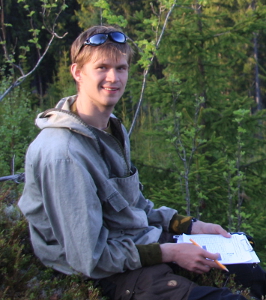Vladimir Naumov will defend his PhD 9th February in forestry, at the Swedish University of Agricultural Sciences, Department of Forestry and Wildlife Management.
The thesis is titled: Barriers and bridges for intensified wood production and biodiversity conservation in NW Russia’s boreal forest
The opponent is Dr.Timo Karjalainen, professor at the University of Eastern Finland
The Defence will take place in Uppsala, at 09:00, 2017-02-09
Abstract
Wood production and biodiversity conservation are two key objectives of sustainable forest management policy. These goals are rival and, therefore, hard to achieve at the same time and space. The aim of the thesis is to contribute to the understanding of barriers and bridges for intensified wood production and biodiversity conservation in NW Russia’s boreal forests. It was implemented by case study approach on both ecological and social systems of forest landscapes with different forest use histories in the European boreal biome.
I first studied the forest use history in a forest management unit in NW Russia (paper I). Second, I analysed how production and biodiversity goals are actually balanced on the ground by comparing indicators for wood production and biodiversity conservation in NW Russia, Belarus, Latvia and Sweden (paper II). Next, in order to test the hypothesis that there are no biophysical obstacles to intensified wood production in NW Russia, I compared tree growth rates at 4 latitudes in NW Russia and Sweden (paper III). Finally, I reviewed the history of forest zoning policy, which is an influential mechanism to conserve biodiversity in Russian forests, and assessed if zoning policy change towards intensification negatively affected riparian forests, e.g. biodiversity conservation (paper IV).
Results from this research shows that barriers for intensified wood production in NW Russia include limited silviculture, poor road development and conservative mind-set of decision-makers (paper I). Bridges for intensified wood production involve existing infrastructure of forest villages and available middle-aged forests (paper I) as well as equal biophysical conditions for tree growths (paper III). Biodiversity conservation goal is achieved better than wood production in NW Russia in comparison to countries with longer forest use histories (paper II). More relaxed zoning policy is considered as barrier to biodiversity conservation (paper IV). Developed zoning system (paper IV), landscape approach initiatives and remaining intact forests (paper I) provide opportunities for biodiversity conservation.
This thesis suggests that balanced sustained-yield wood production together with biodiversity conservation is possible when a segregative zoning model is employed. To conclude, there is a need to engage in transdisciplinary research on the role of landscape stewardship for satisfying both wood production and biodiversity conservation objectives.
Read more about his PhD here.



